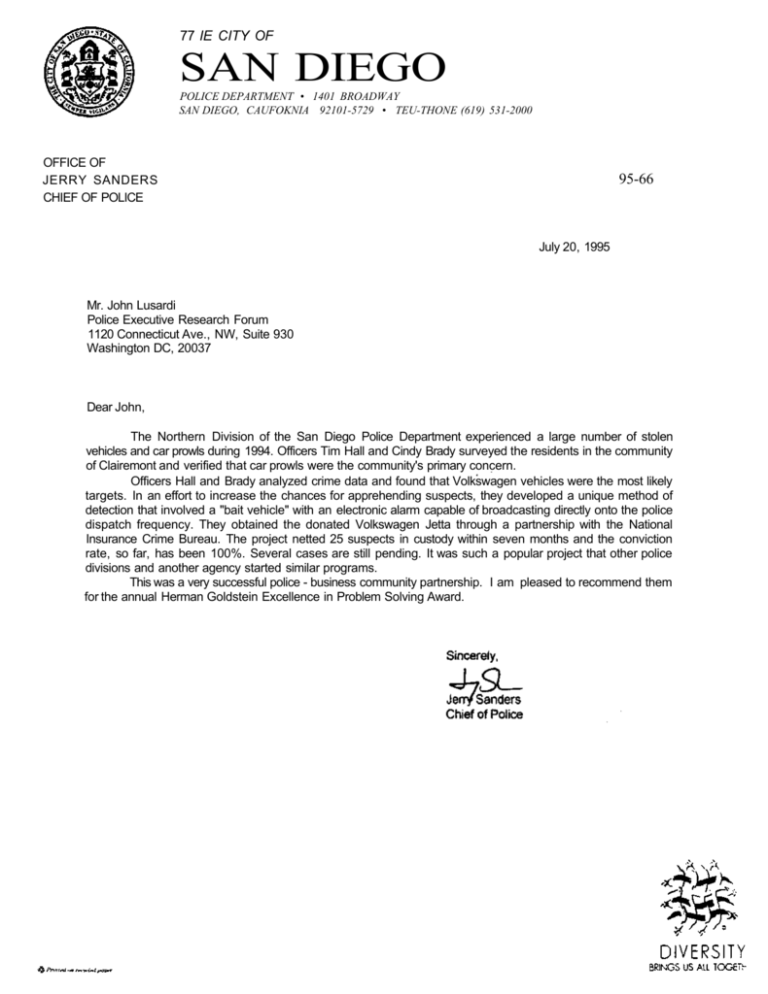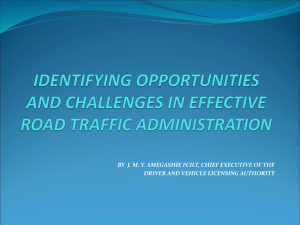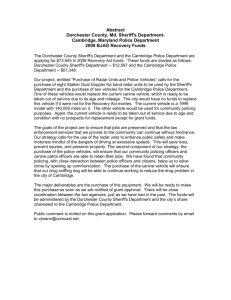SAN DIEGO
advertisement

77 IE CITY OF SAN DIEGO POLICE DEPARTMENT • 1401 BROADWAY SAN DIEGO, CAUFOKNIA 92101-5729 • TEU-THONE (619) 531-2000 OFFICE OF JERRY SANDERS CHIEF OF POLICE 95-66 July 20, 1995 Mr. John Lusardi Police Executive Research Forum 1120 Connecticut Ave., NW, Suite 930 Washington DC, 20037 Dear John, The Northern Division of the San Diego Police Department experienced a large number of stolen vehicles and car prowls during 1994. Officers Tim Hall and Cindy Brady surveyed the residents in the community of Clairemont and verified that car prowls were the community's primary concern. Officers Hall and Brady analyzed crime data and found that Volkswagen vehicles were the most likely targets. In an effort to increase the chances for apprehending suspects, they developed a unique method of detection that involved a "bait vehicle" with an electronic alarm capable of broadcasting directly onto the police dispatch frequency. They obtained the donated Volkswagen Jetta through a partnership with the National Insurance Crime Bureau. The project netted 25 suspects in custody within seven months and the conviction rate, so far, has been 100%. Several cases are still pending. It was such a popular project that other police divisions and another agency started similar programs. This was a very successful police - business community partnership. I am pleased to recommend them for the annual Herman Goldstein Excellence in Problem Solving Award. A Problem Oriented Policing Project Analysis Prepared For The P.E.R.F. Awards Program ACTING SERGEANT TIMOTHY C. HALL and OFFICER CINDY L. BRADY JULY 19, 1995 SCANNING: Upon the inception of the San Diego Police Department Northern Division Neighborhood Policing Team, we conducted a door to door survey of residents in the community of Clairemont Our goal was to determine what residents in the area perceived as their most serious crime problems. The survey was prepared by the members of the Neighborhood Policing Team with input from the San Diego Police Department Crime Analysis Unit. The survey showed that the number one crime concern of Clairemont residents was car prowls, with auto theft following close behind. ANALYSIS: In order to analyze the extent of the problem, we obtained maps and crime report information from Crime Analysis. We were not concerned with specific numbers of crimes, as the survey had shown that the numbers, however large or small, were significant to the residents of Clairemont. Using the maps, we were quickly able to see several areas having high concentrations of car prowls and auto theft within Northern Division. We also saw that relatively few areas within our division were free from these crimes. In analyzing the more specific data we found that Volkswagon Jettas and similar models were the most popular targets of auto theft and car prowls. The majority of Volkswagons stolen in the city were taken from Northern Division. Based upon the theft and recovery location patterns on maps provided by Crime Analysis, we felt there was a strong probability that the majority of the VW thefts were being committed by the same person or persons. RESPONSE: The San Diego Police Department has an Auto Theft Unit and also a Regional Auto Theft Team comprised of detectives from several regional agencies. These units have historically concentrated on sting operations, where they set up a store front and purchase stolen vehicles and car parts, then round up the suspects at the conclusion of the operation. Although highly successful, this type of operation is staffing intensive and expensive. Due to staffing and budget constraints, my partner and I needed to develop an experimental program which would require little additional staffing and almost no funding from the city. We also wanted a program which would allow us to work on our other Problem Oriented Policing (POP) projects at the same time. Our response was to develop the VARDA-Car; a VW Jetta equipped with a VARDA alarm. Something that had never been tried before, to my knowledge. VARDA alarms are self contained radio transmitters which transmit a prerecorded message over the police radio frequency when activated. These alarms were commercially available and had been used by our department for the past two decades. They were typically placed in banks and convenience stores which were likely targets in robbery series. Officers hearing the alarm know that the crime is in progress at the moment they hear it because the notification goes out directly over the police radio frequency, not having to be relayed through a dispatcher. The plan was to park the VARDA equipped bait car in the target area and disable the car so it could not be moved. Disabling the car would delay the suspect, prevent the loss of the bait vehicle, and eliminate the possibility of the vehicle being used in a police pursuit. The vehicle would be disabled by removing electronic engine components. As soon as the suspects -2- broke into the car, the VARDA alarm would be triggered, immediately notifying all officers in Northern Division of the car prowl. The transmitted message would be similar to, "Beep Beep Beep...There is a car prowl in progress at 5500 Mount Aguilar Drive. The vehicle is a black Volkswagon Jetta parked mid block on the north side of the street." The message would repeat three times within twenty seconds then reset. It was a fairly simple idea. Our department had several old VARDA alarms which were rarely used. Using the VARDA alarm would eliminate the need for anyone to actually "watch" the bait car. The bait car would effectively be watched by the entire Northern Division as they monitored their radios while going about their normal duties. All we had to do was come up with the bait car and a way to finance any damage to the car resulting from the break-ins. In this age of drug related property seizures, we naively thought obtaining a free vehicle would be easy. We were wrong. Even though Officer Brady's husband, a Federal Marshal, knew of literally thousands of seized vehicles which would have suited our purposes, red tape and our own city policies prohibited us from using these vehicles. Our second attempt at finding a free vehicle involved a donated vehicle from a local towing yard. That donation was disallowed because the city could not accept a donation from a business which was regulated by the city. After reaching numerous frustrating dead ends, Officer Brady contacted Special Agent Margaret Kibbett of the National Insurance Crime Bureau (N.I.C.B.). We provided Special Agent Kibbett with a memo outlining our proposed project. Special Agent Kibbett was able to convince the N.I.C.B. to loan us a bait vehicle, bait radio, liability insurance, and $1500 for damages to the vehicle. These were initially provided to us on a six month trial basis. The vehicle was a high mileage but clean looking VW Jetta equipped with -3- an expensive Alpine radio and attractive wide wheels and tires. The $1500 was kept in a N.I.C.B. account administered by Special Agent Kibbett. Any time the vehicle was damaged as a result of a break-in, the vehicle was taken to a local repair shop which billed N.I.C.B. directly. They then notified us when the vehicle was ready to be placed back into the field. We did not have to handle or account for any moneyFelony burglary charges are often dropped to misdemeanor vehicle tampering charges because vehicle owners are unable to prove their vehicles were locked when broken into. In order to insure our efforts resulted in felony charges being issued against the suspects arrested in this project, we met with our Deputy District Attorneys to discuss the legal aspects of this project. In California, vehicular burglary, 459 P.C., requires that the suspect break into a locked vehicle. Grand theft, 487. IP.C, requires the stolen property be worth in excess of $400. The DA suggested we use a check-list form when securing the bait car to assure proper documentation of the fact that the bait car was locked prior to being tampered with. They also wanted us to install a stereo worth more than $400 to make any attempt to take the stereo a felony. Provided we followed their guidelines, they assured us they would prosecute any suspects we arrested for felony charges. I installed the VARDA alarm in the trunk of the VW Jetta in the Spare tire well. In order for the VARDA alarm transmitter to have sufficient range, the antenna had to be mounted externally. This was accomplished by drilling a small hole through the floor of the trunk so the antenna protruded under the car through the hole . This method proved to be very efficient and virtually undetectable to the suspects. In order to avoid false alarms, I did not use mercury switches, motion sensors or sound activated switches. I hard-wired the "normally open" trigger -4- terminal of the VARDA alarm into the vehicle's interior dome light circuit at the fuse box, using a relay switch to prevent power from the vehicle going directly to the alarm. The only way for the alarm to be activated was for the suspect to defeat the bait car's locking mechanism and open the car door or trunk. This setup was easy for me to install, requiring only simple hand tools and very little mechanical expertise. The time it takes a suspect to break into a car and leave with the radio is about 1/2 minute. The average response time for officers to arrive at the scene once the alarm was triggered was approximately 1 1/2 minutes. In order to solve this problem, I ran heavy metal cable through the back of the radio chassis and padlocked it to the brake pedal bracket. I allowed just enough slack to let the suspect pull the radio out about one inch from the dash. The VARDA-Car was ready to be placed on the street. But where to put it? In the early days of neighborhood policing, patrol officers were reluctant to participate in POP projects. We wanted the VARDA-Car project to involve the input and participation of all Northern Division personnel. For this reason, rather than using statistical information to determine where crimes had been committed, we asked officers and investigators where they thought the VARDA-Car should be parked. While the VARDA-Car was being outfitted in the police station parking lot, I placed a sign on it identifying it as the "VARDA-Car". Officers quickly became familiar with the appearance of the VARDA-Car as they walked to their patrol cars. I went to squad lineups and explained the project to the officers who would be responding when the alarm was activated. Reception by patrol was lukewarm at best. They did not believe it would work. This called for drastic measures. We offered a reward of a steak dinner to the first officers to take a suspect into custody from the VARDA-Car. -5- ASSESSMENT: Our first placement of the VARDA-Car was in a condominium parking structure. They had experienced a steady stream of car prowls and vehicle thefts, averaging several per week. The property manager eagerly agreed to give us a parking space in the complex. We requested no one other than the property manager be told of the project, just in case their staff were involved in the thefts. We fully expected to have at least one suspect in custody by weeks end. Two weeks later, with no alarm activations, we disappointedly assessed the results. Although we had experienced no alarm activations, there had also been no further car prowls or vehicle thefts from the complex or surrounding neighborhood. Was it a success or failure? Why was it happening? Had the suspects simply left the area? Were they tipped off about the bait car? We quickly became the butt of Northern Division jokes. I went to a squad lineup to elicit their input on why the VARDA-Car had not been hit. The answer came from one of the newer officers, who like most of the other officers at Northern Division, had not been around when VARDA alarms were widely used by the department. That officer said, " I don't understand it either. We drive by there all the time and we never catch anyone in it!" I had obviously failed to adequately explain the concept of the VARDA-Car to those who would be responding to the alarms. Once this was done, we experienced almost immediate success. To date, we have made 25 arrests with our original VARDA-Car. We have had a 100% conviction rate with only one suspect going to trial rather than pleading guilty. The VARDACar has cost the city virtually nothing in equipment or additional staffing. During the operation of the VARDA-Car project we have been able to complete numerous other POP projects. -6- Perhaps the most successful aspect of the VARDA-Car project was the way it brought patrol officers, detectives, and the Neighborhood Policing Team together for the first time. The only negative financial impact associated with this project was the personal cost of the four steak dinners I had to provide to the officers who took the first suspect into custody. The decision to wire the radio chassis to the fire wall proved to be essential to delaying the suspects until responding officers arrived to arrest them. The suspect's frustration over having an almost freed expensive radio in their hands sufficiently warped their perception of time, allowing us to catch them in the car. I no longer have to offer steak dinners to gain the cooperation of patrol officers; the thrill of taking a suspect into custody in the VARDA-Car is sufficient reward. Previously disinterested officers now ask me to place the VARDA-Car on their beats. Detectives and officers have successfully used the VARDA-Car to address series related car prowls. The administration has used the VARDA-Car to address citizen's complaints that we were doing nothing to address the car prowl problem. The success of our original VARDA-Car has prompted the N.I.C.B. to provide our department with four additional vehicles, which are currently being used as VARDA-Cars by other divisions within the San Diego Police Department. Although I have helped the other divisions set up their VARDA-Cars, they are separate from my project. This allows each division to model their project to meet the specific needs of their division. The University of California at San Diego Police were so impressed when they responded to one of our VARDACar alarm activations, they have set tip their own VARDA-Car program. I have also received several inquiries from other police departments throughout the country. -7- One factor which has limited the number of suspects arrested has been the amount of down time incurred during repairs necessitated by break-in damage. To minimize this, it is important to choose a bait car which has a history of being broken into by means other than breaking the window. The VW Jetta proved to be a fairly good choice in that respect. The majority of break-ins were accomplished by suspects inserting screwdrivers through the door next to the door handle and pushing up the lock plunger. Broken windows only occurred in two of the break-ins. This also minimized the cost of repairing the bait car. In most cases, the VARDA-Car was able to be placed back into service without needing repairs. The N.I.C.B. has estimated the average cost to insurance companies of a car prowl insurance claim at $2000. That is more than the total cost of repairs to the original VARDA-Car incurred during the 25 arrests. This represents a significant amount of savings for the insurance companies which fund the N.I.C.B. due to the suppression of car prowls and vehicle thefts resulting from the arrests. The VARDA-Car has not eliminated car prowls and vehicle thefts in the City of San Diego. It has, however provided us with an extremely effective tool requiring very little funding or additional staffing. SUPPORTING DOCUMENTS: Community Survey Check list used when securing the VARDA-Car Arrest statistics -8-







